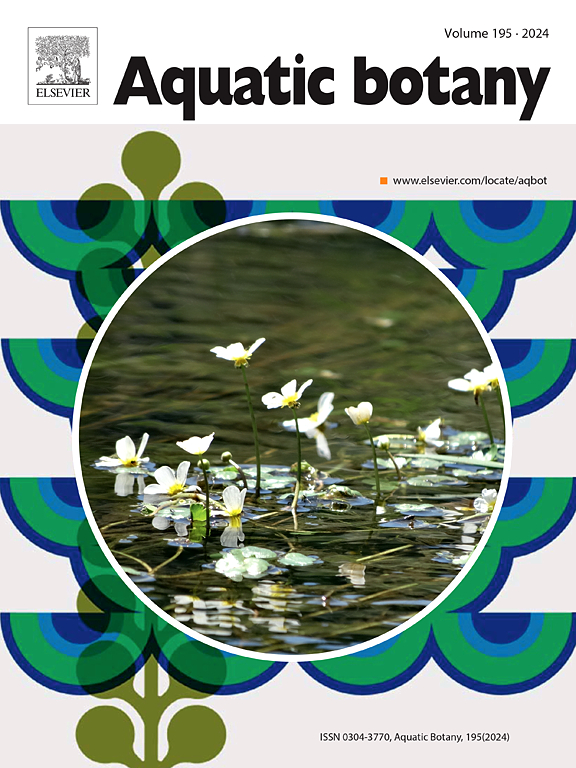Plant characteristics of the non-native seagrass Halophila stipulacea in recently colonized beds of Puerto Rico
IF 2.6
4区 生物学
Q2 MARINE & FRESHWATER BIOLOGY
引用次数: 0
Abstract
The seagrass Halophila stipulacea is native to the Red Sea and Indian Ocean, and since entering the Caribbean in 2002 has spread rapidly throughout the eastern islands including Puerto Rico, and as far as Venezuela and Florida, USA. Despite the research attention to potential ecosystem disruption from H. stipulacea there is little data on the morphology and plant characteristics (e.g. biomass and density) of these new populations. In 2022 we surveyed shallow seagrass communities at 10 sites in 3 bays and characterized plant traits. H. stipulacea was present at 50 % of the sites. We measured leaf morphology on individual shoots, and collected samples for biomass, density, and leaf C:N:P. Density estimates ranged from 3000 to over 11,000 shoots m−2 and biomass varied from 65 and 266 gdw m−2. Mean leaf C:N:P varied between 393:18:1 and 772:27:1 with no strong indications of nutrient limitation. Leaf lengths ranged between 3.7 and 5.4 cm, width varied between 6.7 and 8 mm, with resulting leaf areas ranging between 2 and 3.5 cm2. H. stipulacea leaf area index ranged between 0.6 and 3.9 m2 leaf m2 sediment, with higher LAI values represent a mechanism of self-shading in shallow, clear waters. The range expansion and H. stipulacea beds observed in this study provide supporting evidence that the Caribbean seagrass landscape is changing. Establishing long-term seagrass mapping and monitoring programs would help to assess the impact of this changing seagrass landscape.
波多黎各新殖民床中非本地海草的植物特征
托马海草原产于红海和印度洋,自2002年进入加勒比海以来,已迅速蔓延到包括波多黎各在内的东部岛屿,并远至委内瑞拉和美国佛罗里达州。尽管研究关注于对生态系统的潜在破坏,但关于这些新种群的形态和植物特征(如生物量和密度)的数据很少。2022年,我们在3个海湾的10个地点对浅层海草群落进行了调查,并对植物性状进行了表征。在50% %的位点上发现了托叶菊。我们测量了单个芽的叶片形态,并收集了生物量、密度和叶片C:N:P的样本。密度估计范围从3000到超过11,000芽m - 2,生物量变化范围从65到266 gdw m - 2。平均叶片C:N:P在393:18:1和772:27:1之间变化,没有明显的营养限制迹象。叶长为3.7 ~ 5.4 cm,叶宽为6.7 ~ 8 mm,叶面积为2 ~ 3.5 cm2。叶面积指数在0.6 ~ 3.9 - m2叶- m2泥沙之间,LAI值越高,代表了在浅水、清澈水域的自遮阳机制。本研究观察到的范围扩大和托马床为加勒比海草景观正在发生变化提供了支持证据。建立长期的海草测绘和监测计划将有助于评估这种变化的海草景观的影响。
本文章由计算机程序翻译,如有差异,请以英文原文为准。
求助全文
约1分钟内获得全文
求助全文
来源期刊

Aquatic Botany
生物-海洋与淡水生物学
CiteScore
3.80
自引率
5.60%
发文量
70
审稿时长
6 months
期刊介绍:
Aquatic Botany offers a platform for papers relevant to a broad international readership on fundamental and applied aspects of marine and freshwater macroscopic plants in a context of ecology or environmental biology. This includes molecular, biochemical and physiological aspects of macroscopic aquatic plants as well as the classification, structure, function, dynamics and ecological interactions in plant-dominated aquatic communities and ecosystems. It is an outlet for papers dealing with research on the consequences of disturbance and stressors (e.g. environmental fluctuations and climate change, pollution, grazing and pathogens), use and management of aquatic plants (plant production and decomposition, commercial harvest, plant control) and the conservation of aquatic plant communities (breeding, transplantation and restoration). Specialized publications on certain rare taxa or papers on aquatic macroscopic plants from under-represented regions in the world can also find their place, subject to editor evaluation. Studies on fungi or microalgae will remain outside the scope of Aquatic Botany.
 求助内容:
求助内容: 应助结果提醒方式:
应助结果提醒方式:


